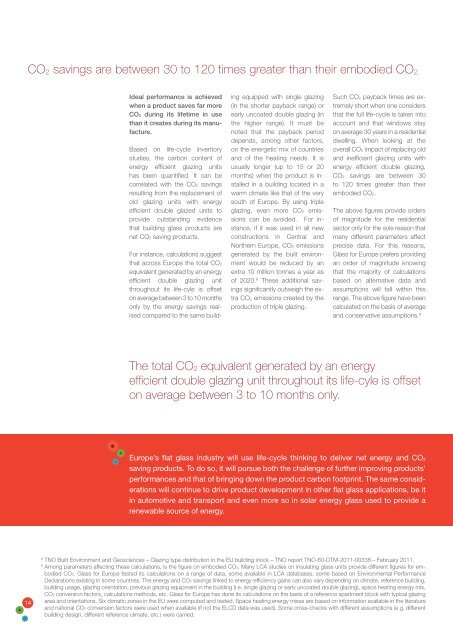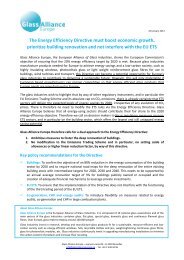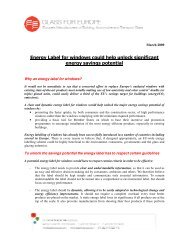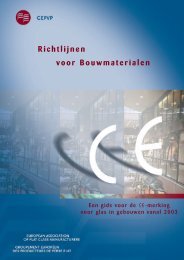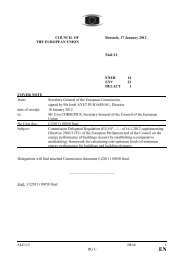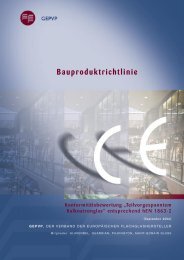Europe's flat glass industry in a competitive low ... - Glass for Europe
Europe's flat glass industry in a competitive low ... - Glass for Europe
Europe's flat glass industry in a competitive low ... - Glass for Europe
You also want an ePaper? Increase the reach of your titles
YUMPU automatically turns print PDFs into web optimized ePapers that Google loves.
CO 2 sav<strong>in</strong>gs are between 30 to 120 times greater than their embodied CO 2<br />
Ideal per<strong>for</strong>mance is achieved<br />
when a product saves far more<br />
CO2 dur<strong>in</strong>g its lifetime <strong>in</strong> use<br />
than it creates dur<strong>in</strong>g its manufacture.<br />
Based on life-cycle <strong>in</strong>ventory<br />
studies, the carbon content of<br />
energy efficient glaz<strong>in</strong>g units<br />
has been quantified. It can be<br />
correlated with the CO2 sav<strong>in</strong>gs<br />
result<strong>in</strong>g from the replacement of<br />
old glaz<strong>in</strong>g units with energy<br />
efficient double glazed units to<br />
provide outstand<strong>in</strong>g evidence<br />
that build<strong>in</strong>g <strong>glass</strong> products are<br />
net CO2 sav<strong>in</strong>g products.<br />
For <strong>in</strong>stance, calculations suggest<br />
that across <strong>Europe</strong> the total CO2<br />
equivalent generated by an energy<br />
efficient double glaz<strong>in</strong>g unit<br />
throughout its life-cyle is offset<br />
on average between 3 to 10 months<br />
only by the energy sav<strong>in</strong>gs realised<br />
compared to the same build<strong>in</strong>g<br />
equipped with s<strong>in</strong>gle glaz<strong>in</strong>g<br />
(<strong>in</strong> the shorter payback range) or<br />
early uncoated double glaz<strong>in</strong>g (<strong>in</strong><br />
the higher range). It must be<br />
noted that the payback period<br />
depends, among other factors,<br />
on the energetic mix of countries<br />
and of the heat<strong>in</strong>g needs. It is<br />
usually longer (up to 15 or 20<br />
months) when the product is <strong>in</strong>stalled<br />
<strong>in</strong> a build<strong>in</strong>g located <strong>in</strong> a<br />
warm climate like that of the very<br />
south of <strong>Europe</strong>. By us<strong>in</strong>g triple<br />
glaz<strong>in</strong>g, even more CO2 emissions<br />
can be avoided. For <strong>in</strong>stance,<br />
if it was used <strong>in</strong> all new<br />
constructions <strong>in</strong> Central and<br />
Northern <strong>Europe</strong>, CO2 emissions<br />
generated by the built environment<br />
would be reduced by an<br />
extra 10 million tonnes a year as<br />
of 2020. 8 These additional sav<strong>in</strong>gs<br />
significantly outweigh the extra<br />
CO2 emissions created by the<br />
production of triple glaz<strong>in</strong>g.<br />
Such CO2 payback times are extremely<br />
short when one considers<br />
that the full life-cycle is taken <strong>in</strong>to<br />
account and that w<strong>in</strong>dows stay<br />
on average 30 years <strong>in</strong> a residential<br />
dwell<strong>in</strong>g. When look<strong>in</strong>g at the<br />
overall CO2 impact of replac<strong>in</strong>g old<br />
and <strong>in</strong>efficient glaz<strong>in</strong>g units with<br />
energy efficient double glaz<strong>in</strong>g,<br />
CO2 sav<strong>in</strong>gs are between 30<br />
to 120 times greater than their<br />
embodied CO2.<br />
The above figures provide orders<br />
of magnitude <strong>for</strong> the residential<br />
sector only <strong>for</strong> the sole reason that<br />
many different parameters affect<br />
precise data. For this reasons,<br />
<strong>Glass</strong> <strong>for</strong> <strong>Europe</strong> prefers provid<strong>in</strong>g<br />
an order of magnitude know<strong>in</strong>g<br />
that the majority of calculations<br />
based on alternative data and<br />
assumptions will fall with<strong>in</strong> this<br />
range. The above figure have been<br />
calculated on the basis of average<br />
and conservative assumptions. 9<br />
The total CO 2 equivalent generated by an energy<br />
efficient double glaz<strong>in</strong>g unit throughout its life-cyle is offset<br />
on average between 3 to 10 months only.<br />
<strong>Europe</strong>’s <strong>flat</strong> <strong>glass</strong> <strong><strong>in</strong>dustry</strong> will use life-cycle th<strong>in</strong>k<strong>in</strong>g to deliver net energy and CO 2<br />
sav<strong>in</strong>g products. To do so, it will pursue both the challenge of further improv<strong>in</strong>g products’<br />
per<strong>for</strong>mances and that of br<strong>in</strong>g<strong>in</strong>g down the product carbon footpr<strong>in</strong>t. The same considerations<br />
will cont<strong>in</strong>ue to drive product development <strong>in</strong> other <strong>flat</strong> <strong>glass</strong> applications, be it<br />
<strong>in</strong> automotive and transport and even more so <strong>in</strong> solar energy <strong>glass</strong> used to provide a<br />
renewable source of energy.<br />
14<br />
8<br />
TNO Built Environment and Geosciences – Glaz<strong>in</strong>g type distribution <strong>in</strong> the EU build<strong>in</strong>g stock – TNO report TNO-60-DTM-2011-00338 – February 2011.<br />
9<br />
Among parameters affect<strong>in</strong>g these calculations, is the figure on embodied CO2. Many LCA studies on <strong>in</strong>sulat<strong>in</strong>g <strong>glass</strong> units provide different figures <strong>for</strong> embodied<br />
CO2. <strong>Glass</strong> <strong>for</strong> <strong>Europe</strong> tested its calculations on a range of data, some available <strong>in</strong> LCA databases, some based on Environmental Per<strong>for</strong>mance<br />
Declarations exist<strong>in</strong>g <strong>in</strong> some countries. The energy and CO2 sav<strong>in</strong>gs l<strong>in</strong>ked to energy-efficiency ga<strong>in</strong>s can also vary depend<strong>in</strong>g on climate, reference build<strong>in</strong>g,<br />
build<strong>in</strong>g usage, glaz<strong>in</strong>g orientation, previous glaz<strong>in</strong>g equipment <strong>in</strong> the build<strong>in</strong>g (i.e. s<strong>in</strong>gle glaz<strong>in</strong>g or early uncoated double glaz<strong>in</strong>g), space heat<strong>in</strong>g energy mix,<br />
CO2 conversion factors, calculations methods, etc. <strong>Glass</strong> <strong>for</strong> <strong>Europe</strong> has done its calculations on the basis of a reference apartment block with typical glaz<strong>in</strong>g<br />
area and orientations. Six climatic zones <strong>in</strong> the EU were computed and tested. Space heat<strong>in</strong>g energy mixes are based on <strong>in</strong><strong>for</strong>mation available <strong>in</strong> the literature<br />
and national CO2 conversion factors were used when available (if not the ELCD data was used). Some cross-checks with different assumptions (e.g. different<br />
build<strong>in</strong>g design, different reference climate, etc.) were carried.


